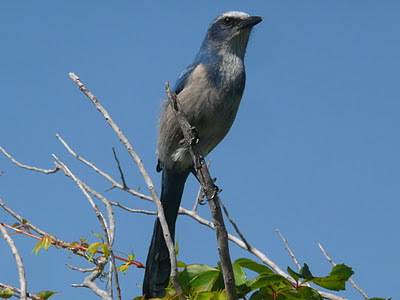Thursday April 26th
Birding at Sanibel Lighthouse
 |
| Yellow-billed Cuckoo at Sanibel Lighthouse |
The spring migration fall-out we are experiencing along Florida's Gulf Coast has benefited us for several days know. Today is day four of the many good sightings continuing at Lee County's Sanibel Lighthouse.
The birds are thinning out and will be probably be gone in a day or so with more favorable winds and full bellies.
I returned both Wednesday and Thursday to the search for a rarely seen in southwest Florida Black-billed Cuckoo. Well I dipped on the bird, but was able to tally some good migrants. I was able to add Yellow-billed Cuckoos, Blue and Rose-breasted Grosbeaks, Summer and Scarlet Tanagers, Baltimore and Orchard Orioles, Lincoln Sparrows, Indigo Buntings, Eastern Wood-Pewees, Verry, Swansen's Thrush, Magnolia warbler, Black-and White Warbler, Blackpoll Warbler, Yellow Warbler, Palm Warblers, Ovenbird, Common Yellowthroat, American Redstart, Hooded Warbler, Prairie Warbler, Red-eyed Vireo and Eastern Screech Owl.
Other additional sightings around the state include bay-breasted warblers, kentucky warblers, cerulean warblers, blackburian warblers and warbling vireos at Ft Desoto park in Tampa Bay and a varied thrush down in
Naples in Collier County.
Toward sundown I caught-up with Bob Pelkey at the drying-up pond at Metro Parkway and Six-mile Cypress Parkway were we found several Black-necked Stilts, a Solitary Sandpiper, a few Semipalmated Sandpipers, a couple of dozen Least Sandpipers and at least one Western Sandpiper. Other birds included Mottled Ducks, Blue-winged Teal, a Swallow-tailed Kite, Wood Storks and the usual waders. Its been a good week.
There is also some anticipation that a repeat blow could happen this weekend and bring-in a fresh wave of migrants. I will also be checking Harn's Marsh next week for any bobolinks as I had found them there in the first week of May these past two years.

 Today after I birded at Six-mile Cypress Preserve, which had very little activity, I noticed several white pelicans flying around the ponds at the 'Metro Ponds'. This at the intersection of Six-mile Parkway and Metro Parkway. So I had to make a stop. There had to be about 180 American White Pelicans situated here today. Other species seen here included Swallow-tailed Kite, Blue-winged Teal, Greater Yellowlegs, Black-necked Stilts, Great Egrets, Snowy Egrets, Little Blue egrets, Tricolored Herons, Common Gallinule, Boat-tailed Grackles, Red-winged Blackbirds, Least sandpipers, and some Rock Pigeons. Did look around for any possible boblinks, but not today.
Today after I birded at Six-mile Cypress Preserve, which had very little activity, I noticed several white pelicans flying around the ponds at the 'Metro Ponds'. This at the intersection of Six-mile Parkway and Metro Parkway. So I had to make a stop. There had to be about 180 American White Pelicans situated here today. Other species seen here included Swallow-tailed Kite, Blue-winged Teal, Greater Yellowlegs, Black-necked Stilts, Great Egrets, Snowy Egrets, Little Blue egrets, Tricolored Herons, Common Gallinule, Boat-tailed Grackles, Red-winged Blackbirds, Least sandpipers, and some Rock Pigeons. Did look around for any possible boblinks, but not today.































